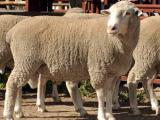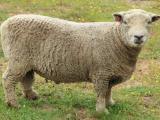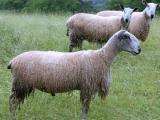
|
Afrino sheepDuring the late 1960's, a request was made to the Department of Agriculture by the wool industry, via the South African Agricultural Union, to develop a white-wooled breed for extensive sheep grazing areas. In 1976, it was evident that the crossing of 25 percent Merino, 25 percent Ronderib Afrikaner, and 50 percent South African Mutton Merino best fullfilled the requirements set for the new breed. |

|
Altay sheepThe Altay originated in the regions of China typified by dry, cold mountain basins. They belong to the Kazakh group of sheep which are found in the desert and mountainous areas in west Xinjiang. Altay belong to the fat-rumped, carpet wool type. They gradually formed the fat tail (or rump) as a biological characteristic. The tail (or rump) weighs about 15 pounds (7 kg). |

|
American Blackbelly sheepThe American Blackbelly is a composite breed resulting from the crossing of Barbados Blackbelly on the Mouflon and Rambouillet breeds. As the name implies, the underbelly of the American Blackbelly is black, as is the inside of the legs, the back part of the thighs, and the hair inside the ears. Two black facial barbs extend down the muzzle medial to the eye, giving the breed an exotic appearance. |

|
Apennine sheepThe Apennine breed was founded in the 1970's in central Italy, mainly in the Toscana, Emilia, Umbria, Arche, and Abruzzi regions of Italy; crossbreeding the local breed with other Italian or exotic breeds such as Bergamasca and Ile-de-France. It is a medium wool breed kept primarily for meat production. It is polled and has semi-lopped ears. |

|
Aragonesa sheepThe Rasa Aragonesa sheep is the second most important Spanish breed after the Merino breed. Spanish sheep breeds of medium quality wool are considered to have originated from the crossbreeding of fine-wool strains (Merino) and those with coarse wool (Churra and Lacha), though this viewpoint is overly simplistic. |

|
Arapawa sheepThe most probable origin for the Arapawa feral sheep is that they are escapees of a flock of mainly Merino origin, known to have been introduced in 1867, the original stock having undoubtedly come from Australia. It is possible that they were introduced earlier by whalers who were the first European occupants of the Island. They are considered a rare and endangered breed. Arapawas are rather prehistoric-looking wild sheep. |

|
Assaf sheepThe Assaf sheep is the result of crossbreeding the Awassi and East Friesian Milk sheep. In 1955, researchers of the Israeli Agricultural Research Organization (A.R.O) started this project aiming to improve the fecundity of the Awassi sheep. A combination of 3/8 East Friesian and 5/8 Awassi blood emerged as the best cross. |

|
Australian Merino sheepMore than 80 percent of all Australian sheep are pure Merino, with most of the remainder at least part Merino blood. Merino is grown primarily for its heavy fleeces of fine wool. Although the Australian Merino derives its name and basic appearance from the Spanish breed, it is a distinct breed in its own right, developed and adapted in Australia to the specific conditions of this country. Merino sheep were brought to Australia from the Cape Colony, England, Saxony (South East Germany), France, and America. The Australian Merino is not a single homogenous breed but a number of strains of sheep all of which, regardless of their origins, are uniquely Australian. The major factor determining the Merino’s development has been the requirement for environmental suitability. |

|
Avranchin sheepThe Avranchin is a grassland breed, hardy and well adapted to the ocean climate, usually living outdoors in small flocks. It is one of the most prolific French breeds. With a large or medium-sized frame, it produces lambs of good butchering quality, with very fine textured meat. |

|
Awassi sheepThe Awassi evolved as a nomadic sheep breed through centuries of natural and selective breeding to become the highest milk producing breed in the Middle East. The breed is of the Near Eastern fat-tailed type. The average Awassi ewe has single lactations over 300 liters (650 pounds) per 210-day lactation, and it is not uncommon for outstanding females to have 210 day lactations above 750 liters (1,625 lbs). |

|
Babydoll Southdown sheepThe Olde English Babydoll Southdown is a miniature variety of the Southdown breed. The Southdown breed of sheep originated in the Southdown hills of Sussex County, England. It is one of the oldest purebred sheep breeds in the world. Southdowns were imported to the United States in the early 1800's. The 1960's saw increased importation of the larger New Zealand Southdown to upscale the American Southdown. |

|
Badger Face Welsh Mountain sheepThe Welsh Mountain Badger Face is a color variation (a recessive trait) of the Welsh Mountain. It is an ancient Welsh breed, which was once common in the Welsh Mountains. Numbers of the breed fell during the Middle Ages when the cloth trade demanded a white wool. Numbers are now on the increase. The main type is known by Torddu which means blackbelly, but there is also a rarer Torwen which is the reverse coloration, black with a white belly. |

|
Balwen Welsh Mountain sheepThe Welsh Mountain Sheep can be termed as an umbrella description to describe many of the breeds indigenous to Wales. Through breeding and selection over the centuries, the Welsh Mountain has developed into many distinct breeds; the Balwen Welsh Mountain Sheep being one of these. Balwen Welsh Mountain Sheep originate from one small area of Wales: the Tywi Valley. The name Balwen is welsh for white blaze. |

|
Barbados Blackbelly sheepThe Barbados Blackbelly is an indigenous breed to the Caribbean island of Barbados. It descends from sheep brought to the islands from West Africa during the slave era. Blackbellies are "antelope like" in appearance, brown tan or yellow in color, with black points and under-parts. Both ewes and rams are polled or have only small scurs or diminutive horns. |

|
Bavarian Forest sheepThe Bavarian Forest, the successor of the Bavarian Zaupel, is decreasing in popularity and appears in the Bavarian herdbook only since 1987. Nevertheless it is an old and once wide-spread breed in its native region. It is a small to medium sheep, mostly white, though brown and black animals do occur. |

|
Belgium Milk sheepThe Belgium Milk Sheep is strongly influenced by Friesian Milk Sheep. In all probability, the Belgium Milk Sheep descends from Flemish sheep. Since the 19th century, Flemish sheep were selected for milk character. After the Second World War, the other milk sheep breeds were added. |

|
Beltex sheepBeltex sheep were first introduced to Britain from Belgium in 1989. They originate from hybrid sheep bred in Belgium. The breed's main characteristics are double-muscled highquarters, coupled with fine bones which ensures maximum killing-out percentage of the finished lamb. |

|
Bergamasca sheepThe Bergamasca originated in the North of Italy, possibly from Sudanese sheep. They are a multi-purpose animal, raised for meat, milk, and wool. They are prolific and produce and average of 250 kg of milk with 6 percent fat over a 6 month lactation period. |

|
Berrichon du Cher sheepThe Berrichon du Cher was established in the Berry region of France. The original breed was crossed with a Merino in the mid-1780's. Further improvements were made in the 1800's with the introduction of the Dishely Leicester. |

|
Beulah Speckled-Faced sheepSpeckled-face sheep have been bred on the hills of Eppynt, Llanafan, Abergwesyn and Llanwrtyd Wells for over 100 years, without introduction of female stock. On the hill, the ewes are normally purebred, providing flock replacements, finished lambs for the meat trade, or store lambs for finishing on lowland farms. |

|
Black Hawaiian sheepThere is some controversy on how the Black Hawaiian breed was started. Some say it is a cross of Mouflon and black hair sheep from the Hawaiian islands. Others say they are Barbados with a dilution of the red color gene making them black. They have a thick black coat and are usually black all over, although some sport a white muzzle. |

|
Black Welsh Mountain sheepIn the Middle Ages, the mutton of black-fleeced Welsh Mountain Sheep was prized for its richness and excellence and much sought-after by merchants. During the mid-19th century, some breeders began to select specifically for the black fleece color and the result is the Black Welsh Mountain sheep. |

|
Blackheaded Persian sheepThe Blackheaded Persian originated in the arid regions of east Africa in what is now Somalia. It is one of the fat-rumped breeds and both sexes are polled. Blackheaded Persians have a white body and black head and neck with the two colors sharply distinguished. |

|
Bleu du Maine sheepThe Blue du Maine originated in Western France in the region of Mayenne. The breed was developed from crossing Leicester Longwool and Wensleydale which were imported during a period from 1855 to 1880 with the now extinct Choletais breed. The Blue du Maine is a large breed. The breed has no wool on its head or legs. The face is dark gray or blue color. Both sexes are polled. |

|
Blue Texel sheepThe Blue Texel is a color variant of the normal white Texel sheep. The Blue Texel came from white Texels who carry the color factor "blue" with them. This factor is a recessive factor. From a mating of two white Texels who both carry the factor for the blue colour, there is a 25 percent chance blue lambs will be born while a mating between a Blue Texel and another Blue Texel always gives blue lambs. Texel sheep evolved as a result of crossbreeding the Dutch polder sheep with several English breeds, such as Leicester, Wensleydale, and Lincoln at the beginning of the 20th century. |

|
Bluefaced Leicester sheepThe Bluefaced Leicester evolved near Hexham in the county of Northumberland, England during the early 1900's. They are descendants of Robert Bakewell’s improved Dishley Leicester. The breed originated from Border Leicester individuals selected for the blue face (white hairs on black skin) and finer fleeces. It was was developed as a sire of high quality crossbred ewes. |

|
Bond sheepBonds evolved in Australia in 1909 as a dual-purpose breed, using Peppin Merinos and imported Lincoln rams. Bonds are tall, long-bodied sheep, heavy in the bone and with open faces and a robust constitution. They produce bulky, long-stapled, bright 22-28 micron wool. Lambs are long, lean, and fast growing. Bond rams weigh up to 150 kg (330 lbs.). |

|
Booroola Merino sheepThe Booroola Merino was developed on the Southern Tablelands of New South Wales, Australia. It differs from the normal Merino in two ways. First, its fertlity is as high as any breed in the world. The number of lambs born per ewe lambing is 2.4, with a range of 1 to 6. Half-Booroola ewes on average wean 20 percent more lambs than comparable Merinos under the same conditions. Secondly, Booroolas have the ability to breed at most times of the year, thus extending the breeding season. |

|
Border Cheviot sheepThe Border Cheviot originated as a mountain breed, native to the Cheviot Hills between Scotland and England, where the climate is harsh and the conditions are rugged. Cheviots are extremely hardy and can withstand harsh winters and graze well over hilly pastures. They were bred to look after themselves. Recognized as early as 1372, the breed is reported to have developed from sheep that swam ashore from shipwrecked Spanish ships that fled northward after the defeat of the Armada. |

|
Border Leicester sheepOne of three distinct breeds of Leicester sheep, the Border Leicester was founded in 1767 by George & Matthew Culley of Fenton, Northumberland, England. They were friends of Robert Bakewell and had access to his improved Leicesters. Some feel that the Culley brothers developed the Border Leicester by crossing Bakewell's improved Leicester rams with Teeswater ewes. Others argue that Cheviot blood was introduced. |
| 1 | 2 | 3 | 4 | 5 | 6 | 7 | 8 |